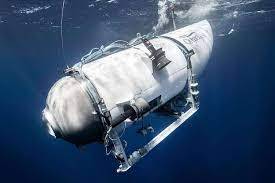
Maritime researchers called an implosion the worst possible outcome of all the scenarios envisioned during the desperate round-the-clock search to find the missing vessel.
The craft went missing Sunday and probably imploded that same day, according to an “anomaly” detected by a U.S. Navy acoustics system, but the international search effort continued because authorities did not consider the information to be definitive.
The Coast Guard announced the deaths from a “catastrophic implosion” on Thursday. Crews are still looking for evidence of what occurred near the Titanic shipwreck, 12,500 feet (3,800 meters) below the surface.
Experts had cautioned that under intense pressure at extreme depths the Titan’s hull could implode, which would result in instant death for anyone aboard the vessel.
While OceanGate Expeditions, which owned and operated the craft, touted the Titan’s roomier cylinder-shaped cabin made of a carbon-fiber, industry experts say it was a departure from the sphere-shaped cabins made of titanium used by most submersibles.
Disclaimer: This is part of a story that was originally published here.

